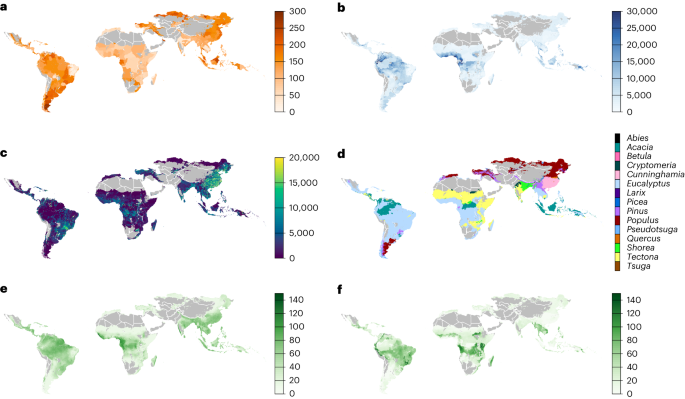天然林再生和人工林减缓气候变化的成本效益
IF 29.6
1区 地球科学
Q1 ENVIRONMENTAL SCIENCES
引用次数: 0
摘要
要经济有效地减缓气候变化,就必须找到每吨温室气体减排成本最低的方法。在此,我们估算并绘制了两种常见重新造林方法的温室气体减排成本图(每吨二氧化碳美元):自然再生和人工造林。为此,我们绘制并整合了重新造林的实施成本和机会成本、可能的植树造林属以及通过自然再生和植树造林进行碳积累的新地图,并考虑了采伐木材产品中的储存。我们发现,在 138 个中低收入国家中约一半适合重新造林的地区,自然再生(46%)和人工造林(54%)的减排成本都较低。在每个地点使用更具成本效益的方法,低于每吨二氧化碳 50 美元的 30 年重新造林时间贴现减排潜力为 31.4 GtCO2(低于每吨二氧化碳 20-100 美元的减排潜力为 24.2-34.3 GtCO2)--比单纯的自然再生高出 44%,比单纯的人工种植高出 39%。我们发现,在低于每吨 CO2 20 美元(每吨 CO2 50 美元)的情况下,重新造林提供的减排量是 IPCC 最新估计值的 10.3 (2.8) 倍。本文章由计算机程序翻译,如有差异,请以英文原文为准。


Cost-effectiveness of natural forest regeneration and plantations for climate mitigation
Mitigating climate change cost-effectively requires identifying least-cost-per-ton GHG abatement methods. Here, we estimate and map GHG abatement cost (US$ per tCO2) for two common reforestation methods: natural regeneration and plantations. We do so by producing and integrating new maps of implementation costs and opportunity costs of reforestation, likely plantation genus and carbon accumulation by means of natural regeneration and plantations, accounting for storage in harvested wood products. We find natural regeneration (46%) and plantations (54%) would each have lower abatement cost across about half the area considered suitable for reforestation of 138 low- and middle-income countries. Using the more cost-effective method at each location, the 30 year, time-discounted abatement potential of reforestation below US$50 per tCO2 is 31.4 GtCO2 (24.2–34.3 GtCO2 below US$20–100 per tCO2)—44% more than natural regeneration alone or 39% more than plantations alone. We find that reforestation offers 10.3 (2.8) times more abatement below US$20 per tCO2 (US$50 per tCO2) than the most recent IPCC estimate. It is important to understand the cost-effectiveness of natural regeneration and plantations, which are common reforestation methods for mitigation. The authors estimate and map abatement costs for the two approaches across low- and mid-income countries, helping to guide reforestation initiatives.
求助全文
通过发布文献求助,成功后即可免费获取论文全文。
去求助
来源期刊

Nature Climate Change
ENVIRONMENTAL SCIENCES-METEOROLOGY & ATMOSPHERIC SCIENCES
CiteScore
40.30
自引率
1.60%
发文量
267
审稿时长
4-8 weeks
期刊介绍:
Nature Climate Change is dedicated to addressing the scientific challenge of understanding Earth's changing climate and its societal implications. As a monthly journal, it publishes significant and cutting-edge research on the nature, causes, and impacts of global climate change, as well as its implications for the economy, policy, and the world at large.
The journal publishes original research spanning the natural and social sciences, synthesizing interdisciplinary research to provide a comprehensive understanding of climate change. It upholds the high standards set by all Nature-branded journals, ensuring top-tier original research through a fair and rigorous review process, broad readership access, high standards of copy editing and production, rapid publication, and independence from academic societies and other vested interests.
Nature Climate Change serves as a platform for discussion among experts, publishing opinion, analysis, and review articles. It also features Research Highlights to highlight important developments in the field and original reporting from renowned science journalists in the form of feature articles.
Topics covered in the journal include adaptation, atmospheric science, ecology, economics, energy, impacts and vulnerability, mitigation, oceanography, policy, sociology, and sustainability, among others.
 求助内容:
求助内容: 应助结果提醒方式:
应助结果提醒方式:


